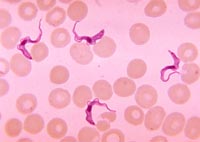What Is Sleeping Sickness?

Trypanosoma forms in
blood smear.
|
Human African trypanosomiasis, sleeping sickness, African lethargy, or Congo trypanosomiasis is a parasitic disease of people and animals, caused by protozoa of the species Trypanosoma brucei and transmitted by the tsetse fly. The disease is endemic in some regions of Sub-Saharan Africa, covering about 36 countries and 60 million people. It is estimated that 50,000 to 70,000 people are currently infected, the number having declined somewhat in recent years. Four major epidemics have occurred in recent history, one lasting from 1896–1906 and the other two in 1920 and 1970. In 2008 there was an epidemic in Uganda.
Symptoms begin with fever, headaches, and joint pains. As the parasites enter through both the blood and lymph systems, lymph nodes often swell up to tremendous sizes. Winterbottom's sign, the tell-tale swollen lymph nodes along the back of the neck, may appear.
If untreated, the disease slowly overcomes the defenses of the infected person, and symptoms spread to include anemia, endocrine, cardiac, and kidney diseases and disorders. The disease then enters a neurological phase when the parasite passes through the blood-brain barrier. The symptoms of the second phase give the disease its name; besides confusion and reduced coordination, the sleep cycle is disturbed with bouts of fatigue punctuated with manic periods progressing to daytime slumber and night-time insomnia. Without treatment, the disease is invariably fatal, with progressive mental deterioration leading to coma and death. Damage caused in the neurological phase can be irreversible.
|